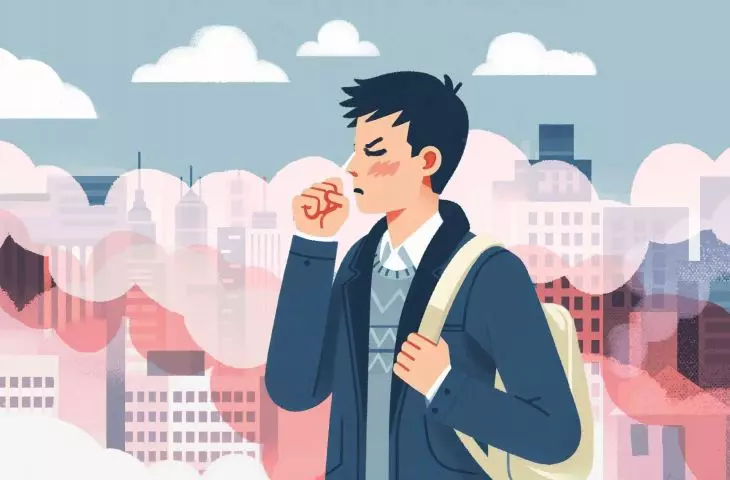Despite significant improvements in air quality in many Polish cities, the problem of smog remains a serious health threat, especially in regions such as Nowa Ruda, Sucha Beskidzka and Nowy Targ, where concentrations of carcinogenic substances exceed acceptable standards.
In Walbrzych, I got off the train at around 9 am. The first thing I smelled was smog. It was the same in Nowa Ruda, Katowice and Chrzanów. It's strange, because all my life, mostly spent in Krakow, I haven't felt it at all. The air smelled different in the winter season, but it certainly didn't stink. I didn't understand friends coming from well-ventilated towns, who said that the smell of my city was like that of a smokehouse. However, a lot has changed, an anti-smog resolution came into effect in Krakow, the level of particulate matter has decreased, and thanks to this I can now feel the difference.
Air quality in European cities - How clean is the air in my city? Map based on levels of fine particulate matter measured in the air in cities in 2022 and 2023.
EEA
The Polish Smog Alert's ranking, based on data from the Chief Inspectorate of Environmental Protection for 2023, shows that Nowa Ruda (Lower Silesia) ranked first in terms of the number of smog days and the average annual concentration of PM10 dust. Sucha Beskidzka (Lesser Poland) had the highest concentration of carcinogenic benzo(a)pyrene, at 600% of the permissible standard. Also at the top of the list of smog record holders is Nowy Targ. It is in the provinces of Malopolska, Silesia and Lodz that we will find the most exceedances of benzo(a)pyrene standards. I asked my observers if they feel smog and how it affects their health.
Three years ago we moved from Wroclaw to Stockholm. It wasn't until we moved that I realized what a huge problem the air quality was, which we took as the norm and didn't pay as much attention to it. Some time ago we visited Wroclaw and, standing on a street in the center of the city, we realized that we could smell the stench and the downright suffocating air. We have a child who stopped having any respiratory health problems after the move. Three years without a single infection, zero antibiotics, inhalations, etc. The whole kindergarten, regardless of the weather, sits outside and there is practically always a set, all healthy.
- Kasia writes.
There are 182 municipalities in Małopolska province, eight of which currently have anti-smog resolutions. The first one was adopted by Krakow in 2016, and took effect three years later. In September 2021, the Małopolska Voivodeship Parliament approved local anti-smog resolutions for seven more local governments, including Oświęcim, Niepołomice, Krzeszowice, Skawina, Rabka-Zdrój, Czarny Dunajec and Nowy Targ, though they do not necessarily apply to the entire area of the municipalities listed. In the case of Nowy Targ, the regulations apply only to the city center, while in Rabka-Zdrój the regulations apply only in the spa zone.
what is this pollution?
Low emission is emission at low altitude.Itcausesthe presence of harmful substances in the air, such as particulate matter (PM 10, PM 2.5, PM 1), sulfur dioxide (SO2), nitrogen oxides (NOx), heavy metals (e.g., mercury, lead), polycyclic aromatic hydrocarbons (PAHs) and dioxins. These substances are dangerous to the health of humans, animals and plants, contribute to smog, the ozone hole, acid rain and cause diseases, including cancer and poisoning.
Illustration of the size of PM10 and PM 2.5 - Europeans are most harmed by fine particulate matter (PM2.5), which is so small that it easily enters the lungs and blood and causes serious health problems. Exhaust particles are no larger than 2.5 micrometers (μm) This is the size of bacteria. 1 micrometer (μm) is one millionth of a meter. An ordinary human hair is about 100 μm in diameter and is about 30 times larger than the largest PM 2.5 particle.
Magdalena Milert
Particulate matter consists of a mixture of airborne solid and liquid particles that can contain toxic substances such as polycyclic aromatic hydrocarbons (including the aforementioned benzo(a)pyrene), heavy metals and dioxins and furans. PM10 dust includes particles with a diameter of less than 10 micrometers, which can reach the upper respiratory tract and lungs, while PM2.5 dust contains particles with a diameter of less than 2.5 micrometers, which can penetrate the bloodstream.
why are you poisoning people?
If I wanted to do a happening in honor of raising awareness of why the air we breathe is important, I would put up a screen in front of every decision-making place with a loopy Magda Gessler asking "why are YOU poisoning people!". Not enough is said about the fact that further air pollution is one of the most serious health risk factors in Europe, especially in urban areas. It is associated with an increase in long-term illnesses that generate significant costs for the health care system. Among the diagnoses are lung disease, diabetes and respiratory infections. Every day, humans inhale about 14 kg of air, which unfortunately contains pollutants that penetrate the lungs and bloodstream[1]. These absorbed substances can cause respiratory diseases such as asthma, and also contribute to the development of lung cancer or strokes. Benzo(a)pyrene is a carcinogen formed mainly during coal and wood combustion and present in tobacco smoke, which can lead to lung, bladder and skin cancer, as well as negatively affect fertility and the development of the nervous system of children in the womb. On average, each resident of European cities incurs annual air pollution costs of more than 1,200 euros[2].
Children of mothers exposed to air pollution have greater problems with memory, attention and concentration, and show higher levels of anxiety. Air pollution affects adult health, increasing the incidence of depressive disorders. Pollution also increases the risk of committing violent crimes[3].
When my girlfriend and I lived in Wroclaw, just going out to the frog in the winter to get a stupid chocolate ended up with my clothes smeared with burnt tires. The very fact that Wroclaw is managed in such a way that the city recommends pregnant women not to go outside when the air quality is low, I find reprehensible.
- writes one of my interlocutors
Exceeding air pollution levels set by the World Health Organization (WHO) has led to at least 253,000 premature deaths in 27 EU countries. More than 100 cities in Europe exceed EU air quality standards, which are less stringent than current WHO guidelines. A study commissioned by Clean Cities 2021 found that 71% of European city dwellers believe authorities should do more to protect public health from air pollution[4].
The air quality problem also contributes to the cost-of-living crisis and the climate crisis, particularly affecting the most vulnerable, who often have the least impact on emissions because they use cars less often. According to the European Environment Agency, concentrations of particulate matter (PM2.5) are on average one-third higher in the poorest regions of the EU-27 compared to the richest.
In Poznań, the problem is multi-family houses, which have no district heating or connected gas but heat with the help of a boiler room, plus, of course, plots of land where people live and also burn anything. I'm trying to understand, because if these are retired people, elderly people who are really having a hard time then what are they supposed to do? Freeze?
- Ada writes
Air pollution also has broad environmental and economic impacts. Ground-level ozone (O3) reduces plant growth, which reduces crop yields and negatively affects biodiversity and ecosystem services. In 2019, countries in the European Union lost more than 5% of their wheat harvests due to high ozone concentrations, resulting in losses of about €1 billion. Nitrogen oxides (NOx) and ammonia (NH3) are deposited in soils and waters, contributing to the eutrophication process. The result is excessive growth of algae, which, when they die, reduce oxygen levels, causing hypoxia and damage to aquatic organisms, and acidification of forest land and freshwater. In 2020, as many as 75% of EU ecosystems were exposed to nitrogen concentrations that promote eutrophication[5].
where it comes from
The largest dust emissions come from burning coal and wood in outdated boilers and household stoves, as well as from burning garbage and waste. The quality of the coal burned is also important. A significant share of dust emissions also comes from transportation, which generates pollution both by burning fuels in engines and secondarily lifting dust from dirty, dilapidated roads. Road transportation is one of the main sources of toxic pollution and emits as much as 37% of nitrogen oxides (NOx).
Industry, especially power generation, chemicals, mining and metallurgy, also contributes to dust emissions. However, due to the height of emitters and regulations limiting permissible emission levels, the impact of this sector on air quality is usually less than that of other sources.
Sources of air pollution - The chart shows the percentage of sources that emit how much of the following pollutants: fine particulate matter PM2.5, particulate matter PM10, ammonia, sulfur dioxide, non-methane volatile organic compounds NMVOCs and nitrogen oxides. Move your mouse over the graph to see more data.
European Environment Agency (EEA)
The largest sources of emissions by sector are: for PM2.5, energy consumption by private, commercial and institutional consumers(58%), for PM10, the same sector (44%), for nitrogen oxides, road transport (37%), and for ammonia, agriculture (94%). PM2.5 can be released directly, mainly from the combustion of fossil fuels and biomass, or formed by the reaction of other pollutants such as nitrogen oxides, sulfur dioxide and ammonia.
A comparison of the 2014 and 2023 rankings shows an unprecedented improvement in air quality.
It is no exaggeration to say that the improvement in air quality in Poland is unprecedented in our history
- emphasizes Piotr Siergiej,
spokesman for the Polish Smog Alarm
In order to effectively reduce the amount of PM2.5 in the air, it is necessary to take structural measures that reduce emissions in entire sectors. It is therefore necessary to keep an eye on both heating, agriculture, transportation, energy generation and industry. Nor is it that we are completely failing to cope. After all, the already notorious Nowa Ruda, despite its leadership position, has reduced benzo(a)pyrene concentrations by a factor of four, and Nowy Targ and Rybnik by a factor of three. The municipality of Godow, once ranked fourth in Poland in terms of average annual PM10 concentrations, dropped to 60th position. Krakow, Katowice and Zabrze, once high in the ranking, saw significant drops - Zabrze from eighth to 81st place.
I moved from Nowy Sącz to Krakow and I can feel a big difference. The air there is not as controlled as in big cities, but we know what that city is famous for. My allergy symptoms have drastically reduced. The air doesn't stink and big clouds of stench don't glide through the streets.
- Margaret writes
None of the localities exceeded the permissible average annual level of PM10, and only three (Nowa Ruda, Sucha Beskidzka, Nowy Targ) recorded the number of smog days above 35 - benzo(a)pyrene concentrations, however, remain high, with permissible values exceeded in 64 localities, and in 11 cases by as much as four times.
corner of good advice
Finally, it is worth sharing some solutions, for example:
-
Replacing outdated heat sources: Replacing old, high-emitting coal and wood boilers with modern, eco-friendly heating systems significantly reduces emissions. Programs such as Clean Air offer subsidies for this purpose.
-
Thermal modernization of buildings: Improving the thermal insulation of buildings reduces energy demand, which leads to lower fuel consumption and reduced emissions.
-
If absolutely necessary, use high-quality fuels: Using certified fuels with low sulfur and ash content reduces emissions of harmful substances into the atmosphere.
-
Development and promotion of public transportation: Investing in environmentally friendly modes of transportation and creating clean transportation zones in cities contributes to reducing traffic emissions.
-
Education and public awareness: Conducting information campaigns on the sources of smog and its impact on health encourages residents to take pro-environmental measures.
-
Enforcement of anti-smog regulations: Regular inspections and enforcement of air quality regulations and punishment for violations are vital to effectively combat smog.
-
Support for renewable energy sources: Promoting and subsidizing installations such as photovoltaic panels and heat pumps reduces dependence on fossil fuels.
-
Increasing urban greenery: Planting trees and creating green spaces in cities helps absorb pollution and improves air quality.
Magdalena Milert
[1] https://www.consilium.europa.eu/pl/infographics/air-pollution-in-the-eu/#0
[2] How much is air pollution costing our health? - EPHA. (October, 2020). https://epha.org/. Retrieved February 5, 2024, from https://epha.org/how-much-is-air-pollutioncosting-our-health/
[3] ędrak, J., Konduracka, E., Badyda, A. J., & Dąbowiecki, P. (n.d.). Impact of pollution on health. Polish Smog Alarm, Krakow Smog Alarm, Warsaw Without Smog. Institute of Physical Chemistry of the Polish Academy of Sciences. ISBN: 978-83-943065-0-2.
[4] Clean Cities. (2024). Clean Transportation Zones: A guide. A. Linares (Lead author), M. Baierl, D. Hale, J. Müller, & B. Stoll (Reviewers). Clean Cities Campaign/ Transport & Environment.
[5] https://www.consilium.europa.eu/pl/infographics/air-pollution-in-the-eu/#0























